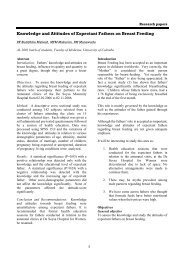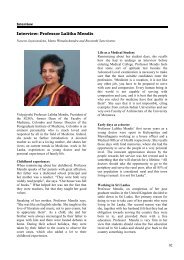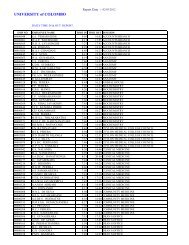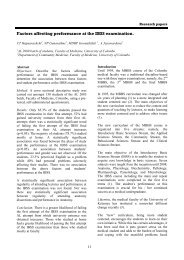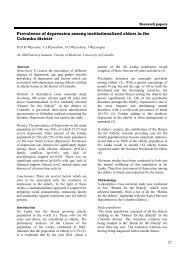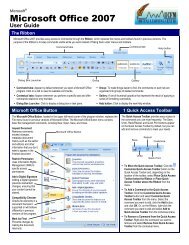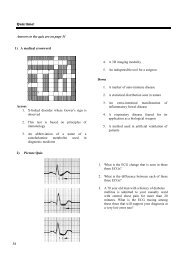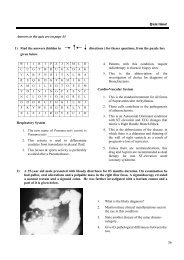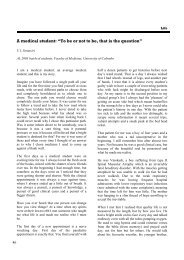Choosing the correct statistical test made easy - Faculty of Medicine ...
Choosing the correct statistical test made easy - Faculty of Medicine ...
Choosing the correct statistical test made easy - Faculty of Medicine ...
Create successful ePaper yourself
Turn your PDF publications into a flip-book with our unique Google optimized e-Paper software.
Q2. Which hypo<strong>the</strong>sis has been <strong>test</strong>ed?<br />
The second question to answer is regarding <strong>the</strong><br />
hypo<strong>the</strong>sis that is to be <strong>test</strong>ed. There are only two<br />
types <strong>of</strong> hypo<strong>the</strong>ses that can be <strong>statistical</strong>ly <strong>test</strong>ed<br />
in research; hypo<strong>the</strong>sis <strong>of</strong> difference or hypo<strong>the</strong>sis<br />
<strong>of</strong> association. Hypo<strong>the</strong>sis <strong>of</strong> difference states that<br />
<strong>the</strong> difference that is shown in <strong>the</strong> results obtained<br />
from <strong>the</strong> samples are also different in <strong>the</strong> larger<br />
populations from which <strong>the</strong> samples came. In<br />
contrast hypo<strong>the</strong>sis <strong>of</strong> association states that <strong>the</strong><br />
relationship <strong>of</strong> <strong>the</strong> two (or more) sets <strong>of</strong> outcome<br />
that we see in <strong>the</strong> results obtained from <strong>the</strong> sample<br />
is also present in <strong>the</strong> larger populations from<br />
which <strong>the</strong> sample came.<br />
In descriptive studies <strong>the</strong> researcher may <strong>test</strong> ei<strong>the</strong>r<br />
<strong>the</strong> hypo<strong>the</strong>sis <strong>of</strong> difference or <strong>the</strong> hypo<strong>the</strong>sis <strong>of</strong><br />
association. For example, if in a descriptive study,<br />
<strong>the</strong> research question to be answered by <strong>statistical</strong><br />
<strong>test</strong>ing is ‘whe<strong>the</strong>r <strong>the</strong>re is a difference in <strong>the</strong><br />
prevalence <strong>of</strong> childhood malnutrition in urban and<br />
rural sectors’ or ‘whe<strong>the</strong>r <strong>the</strong> mean heights <strong>of</strong> <strong>the</strong><br />
three groups <strong>of</strong> basketball players are different’<br />
<strong>the</strong> hypo<strong>the</strong>sis to be <strong>test</strong>ed is hypo<strong>the</strong>sis <strong>of</strong><br />
difference. In contrast to this, if <strong>the</strong> research<br />
question to be answered by <strong>statistical</strong> <strong>test</strong>ing in a<br />
descriptive study is ‘whe<strong>the</strong>r <strong>the</strong>re is a relationship<br />
between stunting and wasting <strong>of</strong> pre-school<br />
children in rural sector’ it indicates that <strong>the</strong><br />
hypo<strong>the</strong>sis <strong>of</strong> association is being <strong>test</strong>ed. Testing<br />
<strong>of</strong> hypo<strong>the</strong>sis <strong>of</strong> association involves<br />
measurements <strong>of</strong> two or more sets <strong>of</strong> outcome<br />
within a single sample whereas <strong>the</strong> <strong>test</strong>ing <strong>of</strong><br />
hypo<strong>the</strong>sis <strong>of</strong> difference will always involve a<br />
measurement <strong>of</strong> a single outcome <strong>made</strong> on two or<br />
more samples.<br />
Experimental research should always <strong>test</strong> only <strong>the</strong><br />
hypo<strong>the</strong>ses <strong>of</strong> difference. For example, <strong>the</strong><br />
research question to be <strong>test</strong>ed using <strong>statistical</strong><br />
<strong>test</strong>ing in an experimental study will be ‘whe<strong>the</strong>r<br />
<strong>the</strong> outcomes are different in <strong>the</strong> study and control<br />
groups’.<br />
Once <strong>the</strong> researcher answers this second question<br />
in <strong>the</strong> checklist, he/she is now able to pick up <strong>the</strong><br />
path to follow in <strong>the</strong> chosen flow chart (Figures 1-<br />
3).<br />
Q3. If <strong>the</strong> hypo<strong>the</strong>sis <strong>of</strong> difference has been<br />
<strong>test</strong>ed, are <strong>the</strong> samples independent or<br />
dependent?<br />
The third question is applicable only if <strong>the</strong><br />
hypo<strong>the</strong>sis <strong>of</strong> difference is being <strong>test</strong>ed. As<br />
indicated earlier, <strong>test</strong>ing for hypo<strong>the</strong>sis <strong>of</strong><br />
association involves measurement <strong>of</strong> two or more<br />
sets <strong>of</strong> outcomes within a single sample; hence this<br />
checklist question becomes irrelevant in such<br />
studies.<br />
In <strong>the</strong> instances where <strong>the</strong> hypo<strong>the</strong>sis <strong>of</strong> difference<br />
is being <strong>test</strong>ed, if <strong>the</strong> selection <strong>of</strong> one <strong>of</strong> <strong>the</strong><br />
samples is in any way influenced by <strong>the</strong> selection<br />
<strong>of</strong> <strong>the</strong> o<strong>the</strong>r samples we call <strong>the</strong>m dependently<br />
selected. An example <strong>of</strong> dependent sample<br />
selection will be when ‘matching’ criteria have<br />
been used in selecting <strong>the</strong> groups to be <strong>test</strong>ed in<br />
ei<strong>the</strong>r descriptive or experimental studies.<br />
Experimental studies in which <strong>the</strong> same subject<br />
acts as his/her own control (within group designs),<br />
are also ano<strong>the</strong>r example <strong>of</strong> an instance in which<br />
samples are dependent on each o<strong>the</strong>r. Following<br />
checking on selection <strong>of</strong> sample, if <strong>the</strong> researcher<br />
is convinced that selection <strong>of</strong> one sample has in no<br />
way influenced <strong>the</strong> selection <strong>of</strong> <strong>the</strong> o<strong>the</strong>r sample,<br />
he/she should consider <strong>the</strong>m as independent<br />
samples. In descriptive studies or in experimental<br />
studies if <strong>the</strong> samples are selected using random<br />
sampling techniques, this will indicate that <strong>the</strong><br />
samples are independent.<br />
Upon answering this third question in <strong>the</strong><br />
checklist, <strong>the</strong> researcher is only one step away in<br />
<strong>the</strong> path to choose <strong>the</strong> <strong>correct</strong> <strong>statistical</strong> <strong>test</strong><br />
(Figures 1-3).<br />
Q4. How many sets <strong>of</strong> measures are involved?<br />
The last question to answer is <strong>the</strong> easiest. It is<br />
about <strong>the</strong> number <strong>of</strong> sets <strong>of</strong> groups or outcome<br />
measures that are involved in <strong>the</strong> analysis. The<br />
question inquires whe<strong>the</strong>r <strong>the</strong> hypo<strong>the</strong>sis <strong>of</strong><br />
difference is being <strong>test</strong>ed on only two groups or<br />
whe<strong>the</strong>r it is more than two. For example, in a<br />
descriptive study <strong>the</strong> research question to be<br />
answered by <strong>statistical</strong> <strong>test</strong>ing is ‘whe<strong>the</strong>r <strong>the</strong>re is<br />
a difference in <strong>the</strong> prevalence <strong>of</strong> childhood<br />
malnutrition in urban and rural sectors’, it<br />
indicates that two groups are being <strong>test</strong>ed. If an<br />
experimental study involves three groups (one<br />
experimental group and two control groups) and if<br />
<strong>the</strong> research question is ‘whe<strong>the</strong>r <strong>the</strong> response to<br />
<strong>the</strong> drug is different among <strong>the</strong> three groups’, it<br />
indicates that more than two groups are being<br />
<strong>test</strong>ed. Similarly in a descriptive study if<br />
hypo<strong>the</strong>sis <strong>of</strong> association is being <strong>test</strong>ed and <strong>the</strong><br />
question to be answered by <strong>statistical</strong> <strong>test</strong>ing is<br />
‘whe<strong>the</strong>r <strong>the</strong>re is a relationship between stunting<br />
and wasting <strong>of</strong> pre-school children in rural sector’<br />
it indicates that two sets <strong>of</strong> outcomes are being<br />
<strong>test</strong>ed. If <strong>the</strong> research question is to <strong>test</strong> ‘whe<strong>the</strong>r<br />
36



